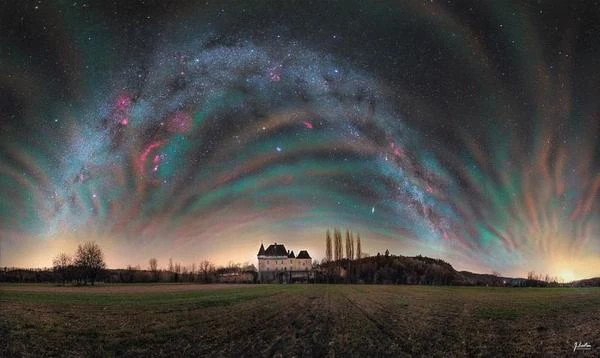
Image description: The Milky Way photographed by Julien Loteen on January 21, 2023 at the foot of the Château de Losse (Dordogne, France).
This unusual sky above the Chateau shows a spectacular airglow.
The curved appearance of our Milky Way is due to the wide angle of the camera lens.
In the arc of the Milky Way at the bottom left above the trees, we notice Sirius, the bright white star. Above the Castle, we see the blue spot of the Pleiades star cluster. Above the Pleiades on the right, the red California nebula. The planet Mars is to the left of the California Nebula. Above the cypress trees on the right, the blue Andromeda galaxy. Image source: Creative Commons Julien Looten.
Airglow is a faint glow propagated by the Earth's atmosphere at night. This faint glow is mainly caused by the recombination of excited atoms and molecules after absorbing solar energy during the day.
During the day, the Earth's atmosphere absorbs solar energy, especially in the upper layers of the atmosphere. When this solar energy is absorbed, the atoms and molecules (oxygen, nitrogen) present in the atmosphere become excited, that is, they acquire additional energy. Which can lead to the ionization of certain atoms and molecules. Ionization occurs when electrons are stripped from an atom, leaving one positively charged ion and one free electron.
During the night, when the direct input of solar energy is no longer present, these excited particles begin to return to their normal energetic state. Free electrons can recombine with ions to form neutral atoms or molecules. This recombination process releases energy in the form of photons, revealing a colored airglow.
Airglow is therefore a weak and diffuse glow which can be perceptible in certain places, far from the light pollution of urban areas.
Airglow colors can vary depending on the types of atoms and the level of excitation and the particular electronic transitions that occur. For example, when oxygen atoms are excited, they typically emit green or red light. When nitrogen atoms are excited, they typically emit in the blue and violet range.
The color of nocturnal airglow has a dominant blue-green color, while polar airglow is predominantly red. The airglow that occurs during the day (dayglow) is primarily blue.
N.B.:
This physical phenomenon, which is very difficult to observe, was first noticed in 1868 by Anders Jonas Ångström (1814-1874), a Swedish astronomer and physicist.